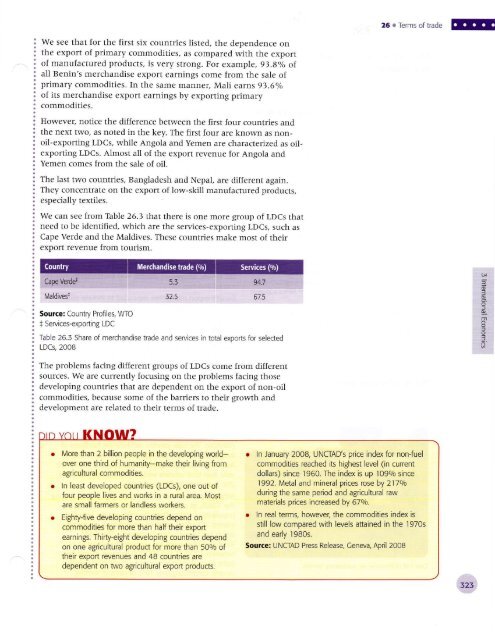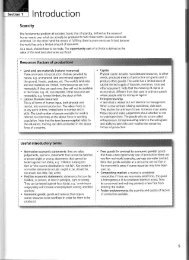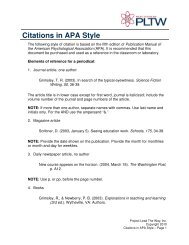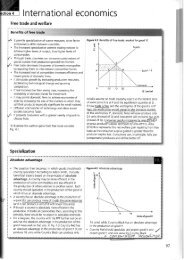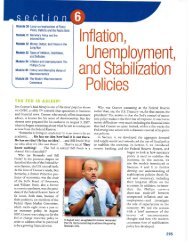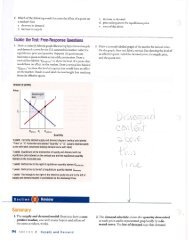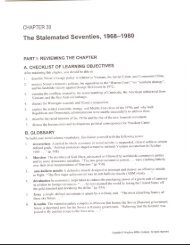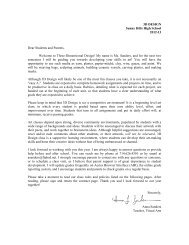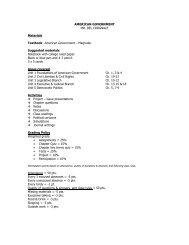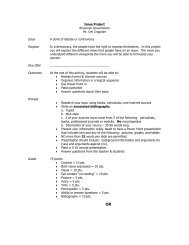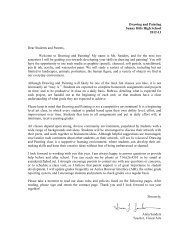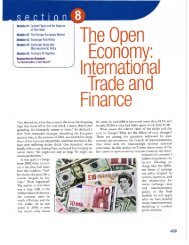IB Econ Chap 26 Terms of Trade - Sunny Hills High School
IB Econ Chap 26 Terms of Trade - Sunny Hills High School
IB Econ Chap 26 Terms of Trade - Sunny Hills High School
You also want an ePaper? Increase the reach of your titles
YUMPU automatically turns print PDFs into web optimized ePapers that Google loves.
We see that for the first six countries listed, the dependence on<br />
the export <strong>of</strong> primary commodities, as compared with the export<br />
<strong>of</strong> manufactured products, is very strong. For example, 9).8o/o o!<br />
all Benin's merchandise export earnings come lrom the sale <strong>of</strong><br />
primary commodities. In the same manner, Mali earns 91.6%<br />
<strong>of</strong> its merchandise export earnings by exporting primary<br />
commodities.<br />
Howeve! notice the difference between the first four countries and<br />
the next two, as noted in the key. The first four are known as nonoil-exporting<br />
LDCs, while Angola and Yemen are characterized as oilexporting<br />
LDCs. Almost all o{ the export revenue for Angola and<br />
Yemen comes from the sale <strong>of</strong> oil.<br />
The last two countries, Bangladesh and Nepal, are different again.<br />
They concentrate on the export <strong>of</strong> low-skill manufactured products,<br />
especially textiles.<br />
We can see from Table <strong>26</strong>.3 that there is one more group <strong>of</strong> LDCs that<br />
need to be identified, which are the services-exporting LDCS, such as<br />
Cape Verde and rhe Maldives. These countries make most <strong>of</strong> their<br />
export revenue from tourism.<br />
Source: Country Pr<strong>of</strong>iles, WIO<br />
f Services-exporting LDC<br />
Table <strong>26</strong>.3 Share <strong>of</strong> merchandise trade and services in total exports for selected<br />
LDCS, 2008<br />
The problems facing different groups <strong>of</strong> LDCs come from diflerent<br />
sources. We are currently focusing on the problems facing those<br />
developing countries that are dependent on the export <strong>of</strong> non-oil<br />
commodities, because some <strong>of</strong> the barriers to lheir growth and<br />
development are related to their terms ol trade.<br />
32.5<br />
More than 2 billion people in the developing worldover<br />
one third <strong>of</strong> humanity-make their living from<br />
agricultural commodities.<br />
ln least developed countries (LDCS), one out <strong>of</strong><br />
four people lives and works in a rural area. Most<br />
are small farmers or landless workers.<br />
Eighty{ive developing countries depend on<br />
commodities for more than half their export<br />
earnings. Thirty-eight developing countries depend<br />
on one agricultural product for more than 500/o <strong>of</strong><br />
their export revenues and 48 countries are<br />
dependent on t\ /o agricultural export products.<br />
67.5<br />
<strong>26</strong>. <strong>Terms</strong> ot trua" [!<br />
o ln January 2008, UNCIAD's price index for non-fuel<br />
commodities reached its highest level (in current<br />
dollars) since 1960. The index is up 1090/0 since<br />
1992. Metal and mineral prices rose by 2l7olo<br />
during the same period and agricultural raw<br />
materials prices increased by 67010.<br />
. ln real terms, however, the commodities index is<br />
still low compared with levels attained in the 1970s<br />
and eady I980s.<br />
Source: UNCIAD Press Release, Ceneva, April 2008<br />
323<br />
d<br />
o<br />
rn<br />
q<br />
o<br />
l.


